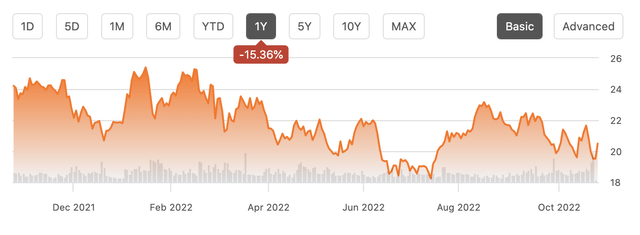ablokhin/iStock Editorial via Getty Images
Shares of Regions Financial (NYSE:RF) have been a middle-of-the-pack performer over the past year among regional banks as investors weigh higher interest rates against worsening credit metrics in a potential recession. The company’s third quarter results were similarly better than some regionals like Fifth Third (FITB) but worse than others like Citizens Financial (CFG). At about 10x earnings, I view Regions as a hold. It is reasonably valued, but I see greater upside elsewhere in the sector.
In the company’s third quarter, Regions earned $0.43, which was $0.11 short of consensus as noninterest expense fell and the company faced some hurricane-related provisions. The company had earned $0.65 last year, though this benefited from a reserve release as the economy was sharply recovering from the COVID lockdowns.
Regions showed the sensitivity to higher rates that investors want to see from regional banks during a Federal Reserve tightening cycle. Net interest income rose from $1.11 billion to $1.27 billion QoQ. This represented growth of over 30% from last year. Its net interest margin (‘NIM’) expanded from 3.06% to 3.53% in the quarter. The change in rates boosted its assets’ income by 46bp while increased deposit costs were just an 8bp drag.
Regions report solid loan growth of 4% QoQ even as utilization of credit lines decreased. This means the company is gaining share and bringing on new clients, rather than seeing increased borrowing from its existing client base. The company reported growth in both consumer and corporate loans. I would note its treasury management offering grew its client account by 11.7%, and these clients become ideal targets to lend to. RF is well positioned to grow its loan book, and it expects to do just that in Q4 albeit at a somewhat slower pace in part because its loan book is larger now.
On the more negative side, deposits fell by $4.1 billion, or 3% with particular softness in the corporate bank. Some of this deposit loss by Regions represents an active choice as it is simply not increasing the rate it offers very much. In Q3, its deposit cost was just 0.15%, one of the lowest among banks that have reported. This meant RF passed on just 11% of the higher rates to its customer. Personally, I prefer banks that are holding on to deposits as they are stable, low-cost funding. But, I do prefer RF or Comerica’s (CMA) results to Fifth Third, which reported weak deposits even as it raised rates meaningfully.
Regions is making the strategic discussion that they have excess liquidity, meaning that they can afford to underprice deposits and have more attrition. This strategy can be quickly changed if the company feels a need to retain deposits, by raising rates. With its beta so low, RF can afford to pass on more of future rate hikes while still growing its net interest income if it has to. The company has a 10% cash-to-earning assets ratio meaning it will not need to turn to more expensive wholesale funding even if deposits continue to tick down. Similarly, loans are just 70% of deposits.
Management is guiding for deposits to fall $5-10 billion this year. This implies another $3-8 billion in Q4 deposit attrition. I believe this situation merits further monitoring, but for now, the company has plenty of liquidity to let more deposits leave for higher rates elsewhere.
Elsewhere, noninterest income fell by over 5% to $605 million as it reduces overdraft fees. Capital markets activities also fell by 22% from last quarter. Wealth management revenue was up 6%, which is really quite strong given weaker financial markets. In this unit, Regions generated 9% non-interest income growth as its client count rose by 5%, and it generated 10% more revenue per client.
Regions took $146 million in provisions for credit losses (adjusting for the hurricane and a loan portfolio sale). It has $1.539 billion in allowances for credit losses, up $25 million from last quarter. This covers 1.63% of all loans and provides 3x coverage of its $495 million in nonperforming loans. This provision was an increase from last quarter’s $60 million, given the weaker economic outlook. Given its strong coverage of nonperforming assets and slower loan growth going forward, I would not expect provisions for credit losses to continue to increase above Q3’s pace, though I would note Regions is seeing “some stress” in its office portfolio.
In Q4, management expects net interest income to be up 7-9% sequentially, which would represent a 33-35% increase from Q1. This is about a $100 million sequential tailwind, meaning its credit losses could rise by 67% from here, and the company’s earnings would still be flat to Q3. This is the power of higher rates, which should insulate RF shareholders from modest-to-moderate incremental credit deterioration.
RF does engage in a modest hedging program to insulate its NIM from volatility in interest rates. Regions has been slowly adding to its hedges, though it has hedged just about 20% of its floating rate exposure. It expects to hedge another $5 billion this quarter to protect a NIM of around 3.6%. Given the majority of its assets are unhedged, the company’s interest income still offers plenty of upside if the Fed raise rates more than expected.
Region’s CET1 capital ratio rose from 9.2% to 9.3% in the quarter. Management targets being in the upper end of its 9.25-9.75% stated range. During Q3, it did not do any share repurchases, and it is unlikely to do material buybacks in my view until mid-2023 at the earliest, given the goal to increase capital. Regions does offer a 4.1% dividend yield, and I view this payout as secure given its strong earnings run rate.
At first, shares may look expensive over $20 given tangible book value is $8.15. However, RF has a $29.6 billion portfolio of fixed-rate securities. Given the rise in rates, these assets have lost quite a bit of value, which flows through to accumulated other comprehensive income (AOCI). At the end of Q3, AOCI was -$3.6 billion from $289 million at the start of the year. Because these securities will largely be held to maturity and repay at par, investors should adjust for this, which means tangible book value is about $12.
Overall, RF is reporting solid loan and client growth, though its deposit attrition bears watching. Its capital is a little lighter than preferred, which will also limit buybacks. Given my view credit losses are largely normalizing here, RF has about $2-$2.10 in earnings power over the next year, thanks to higher rates. I view 10x earnings as fair, given the risk of a recession and some risk around its deposit strategy. I would rather be in companies like CFG that offer lower earnings multiples and more resilient deposit performance, however.



Be the first to comment